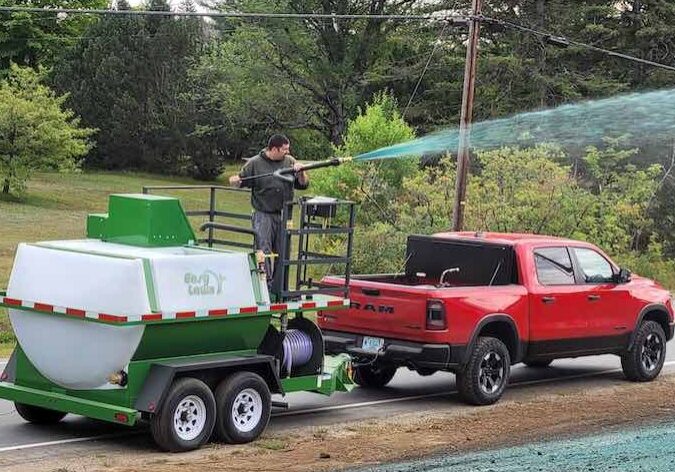How Long Does Hydroseed Take To Grow?

Share this article!
A lush, green lawn is just about as synonymous with the American Dream as you can get, and one of the better ways to get a yard that’s the envy of the neighborhood is with hydroseeding. Hydroseeding can be a quick and effective way to establish a healthy new lawn that will look great years into the future.
The length of time it takes hydroseed to completely grow in can vary by seed selection, region, climate, and even project to project, but in general you can expect hydroseed to sprout within 5-10 days and to have a full, usable lawn within 3-5 weeks. We’ll explore the different factors that can influence how long it takes hydroseed to grow, as well as tips and tricks for troubleshooting common hydroseeding issues.
Hydroseed Growth Process
Used by professional landscapers and homeowners alike, hydroseeding can be a great choice to seed large or hard-to-reach areas, steep slopes, and other locations that aren’t easy to sod or hand seed. Because of the way hydroseed is applied — as a combination of fertilizer, seeds, tackifier, and dye with a hydroseeding machine — the growing time for hydroseed is often faster than other methods.
Hydroseed germinates in 5-10 days
The rule of thumb with hydroseed germination time is that you can expect seed growth anywhere between 5 to 10 days after seeding. Temperatures and moisture levels are the factors that influence germination time for hydroseed the most. For example, if temperatures are mild (somewhere above 55 degrees Fahrenheit, but below 85 degrees Fahrenheit) and moisture levels are consistent, seeds will typically sprout sooner than if temperatures are routinely below 55 degrees Fahrenheit or above 85 degrees Fahrenheit. The type of seeds used also impacts how quickly germination starts, as some seeds sprout more quickly than others.
Hydroseed takes approximately 3-5 weeks to reach full growth
Establishing hydroseed generally takes about 3 weeks, though like germination, this process can vary. The typical range is anywhere from 3 to 5 weeks, on average. Different varieties of grasses take different times to grow and establish reliable root systems. The soil content, weather and climate, and watering schedule also impact how long hydroseed takes to grow to maturity. The care you take of the hydroseed, like regular watering and fertilizing, can also expedite the germination process.
Factors That Affect Hydroseed Growth Time
Like plants of all kinds, the different kinds of grasses grown from hydroseed takes different amounts of time to germinate and grow. The conditions seeds find themselves in also impact how quickly, or not, hydroseed takes to grow. The most common conditions that impact growing time for hydroseed however, are generally contained to a few key factors:
Soil Conditions
The type and condition of soil can make or break hydroseeding results, and can be a contributing factor for hydroseed not growing. Both the composition of soil, and the shape the soil is in, impact how successful your hydroseeding is, and how quickly it establishes. For example, if you’re hydroseeding an area near a construction site where the ground is heavily compacted, tilling the soil and decompacting it will be essential for the best hydroseed results.
Testing the soil is another useful step toward getting ideal results from hydroseeding. Soil testing will reveal the chemical composition of the soil and its pH, so you’ll be able to make informed decisions about adding fertilizers or nutrients to help hydroseeds have the best possible chance to grow thick and healthy.
Weather Conditions
The climate is another key factor in determining the length of time hydroseed takes to grow, in addition to how well it grows in. Because of their moderate temperatures, spring and fall are the recommended times of year to hydroseed. If the temperature is too cold, freezing or approaching freezing, it can slow down seed germination, and can even kill seeds in some cases.
On the other hand, if the temperatures are too hot, seeds may not have enough moisture and can take longer to germinate. Ideally, hydroseeding in weather between 65 and 75 degrees Fahrenheit is preferable for the best results.
Mild temperatures are ideal for hydroseeding, and can give seeds the best chance to germinate quickly and grow well. Consistent watering is also essential, which is another reason that spring and fall are preferred times of year for hydroseeding. During these times of year, it generally costs less in water to keep seeds wet enough, consistently enough, for proper germination.
Type of Seed
Some kinds of grass seeds germinate quickly, while others take more time. Ryegrass and Bermuda grass are often the fastest germinating of the grass seeds available — with Bermuda grass taking between 3 and 7 days to germinate, and Ryegrass typically taking between 5 and 10 days, in ideal conditions. Other species like fescues and bentgrasses can take longer, more often between 7 and 14 days.
The types of seed are also important to consider for your particular project, since some species of grass are better suited for different types of climates. It’s best to do some research to find the right fit of grass seed for your area. Hydroseeding can also use a combination of different types of seeds, so you can mix seed species for a resilient lawn.
Watering
Consistent, even watering is essential for hydroseed to establish and grow well. Depending on the climate and weather, a watering plan between 2-4 times per day, for roughly 10-20 minutes at a time should keep the ground moist enough to encourage healthy germination. If seeds don’t have enough water, often enough, they may take longer to germinate and not grow as consistently. If the weather is especially hot or dry, plan to increase your watering schedule to keep the ground evenly moist to give seeds the best chance to germinate.
Troubleshooting Tips for Hydroseed Not Growing
In addition to the factors that impact hydroseed growth time, there are a few additional issues that can affect hydroseeding results. If you’re looking for reasons for hydroseed not growing, it’s likely one of the below:
Shade/Not Enough Sunlight
Like many plants, grass needs sunshine, and plenty of it, to get a good start. If hydroseeding is done in a shady area, expect that it will take longer to germinate and not grow as well as in other areas that receive more sunlight.
Traffic too Soon
Grass seeds can be bothered by foot and other kinds of traffic, especially before they’ve had a chance to establish. It’s important not to disturb the hydroseeded area or to allow traffic of any kind (kids, pets, machinery, etc.) on it before the hydroseed is ready. When the grass has reached a length of 2-3 inches, and is ready for its first mow, then it’s ready for action. Disturbing the seeds before this time risks damaging and displacing the seeds, which can negatively affect how well seeds establish and grow in.
Takeaway
While hydroseeding results can vary project by project, and depend on the conditions, paying attention to a few key factors can help set your hydroseeding project up for success, no matter the weather or terrain.
Easy Lawn offers a range of hydroseeders, from mini hydroseeders to larger hydroseed trailers to help you grow beautiful hydroseeded lawns. Get in touch with us to learn more.

